-
Welcome! The TrekBBS is the number one place to chat about Star Trek with like-minded fans.
If you are not already a member then please register an account and join in the discussion!
You are using an out of date browser. It may not display this or other websites correctly.
You should upgrade or use an alternative browser.
You should upgrade or use an alternative browser.
Fan Filmmaker's Primer
- Thread starter Maurice
- Start date
So, here's the film we shot at The Producer's Loft Studio as seen in the photos above. We literally made this in 4 days, start to finish, including the scriptwriting...
....I'll talk about some specific technical stuff and production realities and how I designed this to make limitations a strength in an upcoming post. Hopefully this will all be useful to some of you.
Okay, long overdue to follow-up on the above... but here goes.
A Quick Précis on Blocking, Framing and shot Composition
In most fan films and amateur productions the camera angles and blocking are rudimentary, sometimes barely functional. This character talks, so the camera points at them. These characters do something, so the camera points at them. But you can do a lot more than that. How and where you position and move characters in the scene, how you frame them and where the camera is in terms of what and who it sees and from which angles can tell parts of the story or add layers of meaning.
As The Limbo Set was an extremely limited and fast shoot it was created under many of the constraints as most fanfilms. Humble as it is, I think it can serve to simply illustrate how much value there is in thinking through blocking, shot choice and framing. So let's look at some pictures and talk about why the actors are blocked and why the shots are framed the way they are.
TOGETHER BUT APART
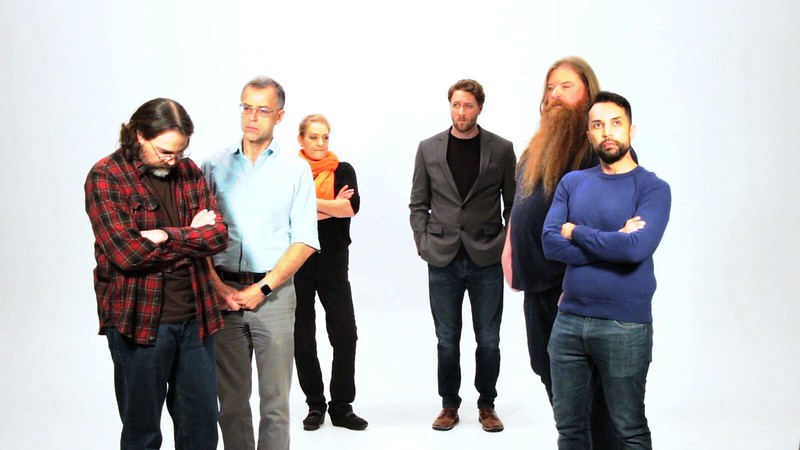
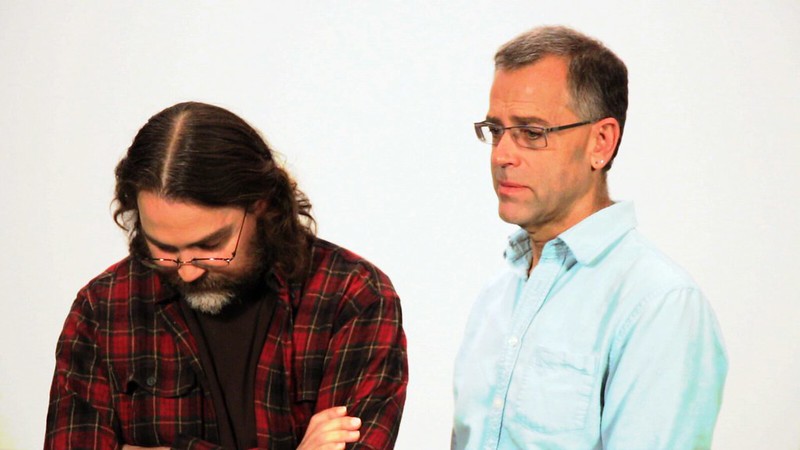
SPOILERED
COMMUNICATION VIA SIMPLE ACTION AND MOVEMENT
Now, the nature of the film and the limitations of the set suggests stillness and that could be visually dull, so I decided to create contrasting movement in Beckett/god's second appearance. A common mistake of novice filmmakers is trying to make things busy or contain action merely for visual interest but oftentimes that is counter-productive because if the action and/or camera moves are not "motivated" they might undermine or contradict the intent of the scene rather than support or counterpoint it.
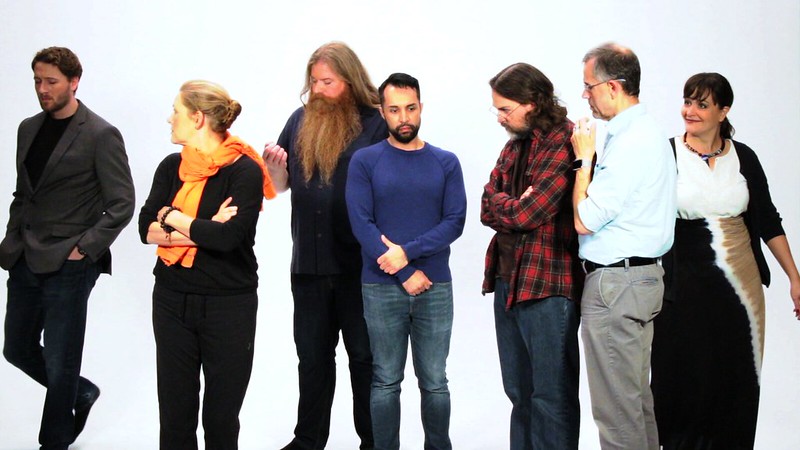
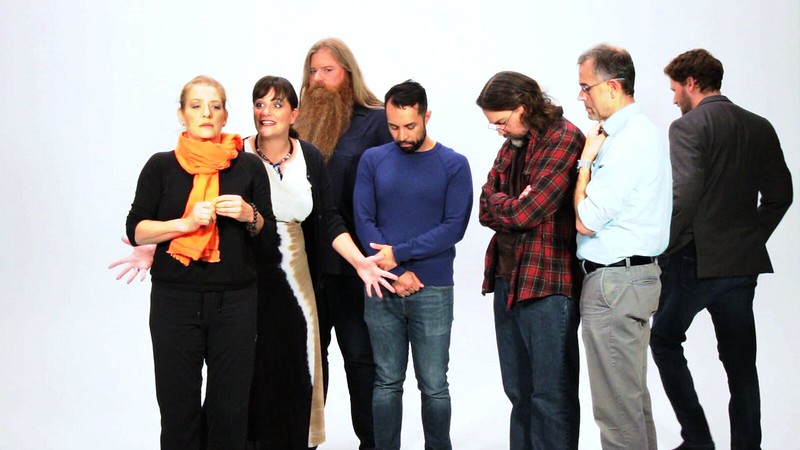 In this scene the action is designed to tell us something: Taylor paces like a nervous caged animal and then Beckett/god casually circles in the opposite direction as a complete contrast. He's literally and figuratively going in circles. She freely weaves into and through the group then exits in a straight line thus showing that they can find "ways out". The script called for this to be a down shot (from the balcony overlooking one side of the stage) but concerned about time I chose to play it on the level. I wish I'd gotten at least one quick take of it from above to break things up. C'est la vie...
In this scene the action is designed to tell us something: Taylor paces like a nervous caged animal and then Beckett/god casually circles in the opposite direction as a complete contrast. He's literally and figuratively going in circles. She freely weaves into and through the group then exits in a straight line thus showing that they can find "ways out". The script called for this to be a down shot (from the balcony overlooking one side of the stage) but concerned about time I chose to play it on the level. I wish I'd gotten at least one quick take of it from above to break things up. C'est la vie...
Notice also that the limbo people never actually make eye contact with Beckett. I instructed them to do this so to suggest that either they can't see or are ignoring her... without specifying which it is. You choose.
VISUAL SYMBOLISM WITH A SIMPLE PROP
 The limbo game appears seemingly from nowhere and with no fanfare. It either arrived unseen or perhaps it was there all along and no one noticed it before. It initially appears as three vertical rods perhaps subtly suggesting a cage or prison bars behind which these pour souls feel trapped. See it?
The limbo game appears seemingly from nowhere and with no fanfare. It either arrived unseen or perhaps it was there all along and no one noticed it before. It initially appears as three vertical rods perhaps subtly suggesting a cage or prison bars behind which these pour souls feel trapped. See it?
 But as soon as one of them reaches for the center rod it falls over. It occurred to me afterwards that this immediately suggests this cage is a pretty flimsy one and perhaps the cage door was never closed or locked to begin with. As Beckett/god says at the top of the film—"you can leave any time you want".
But as soon as one of them reaches for the center rod it falls over. It occurred to me afterwards that this immediately suggests this cage is a pretty flimsy one and perhaps the cage door was never closed or locked to begin with. As Beckett/god says at the top of the film—"you can leave any time you want".
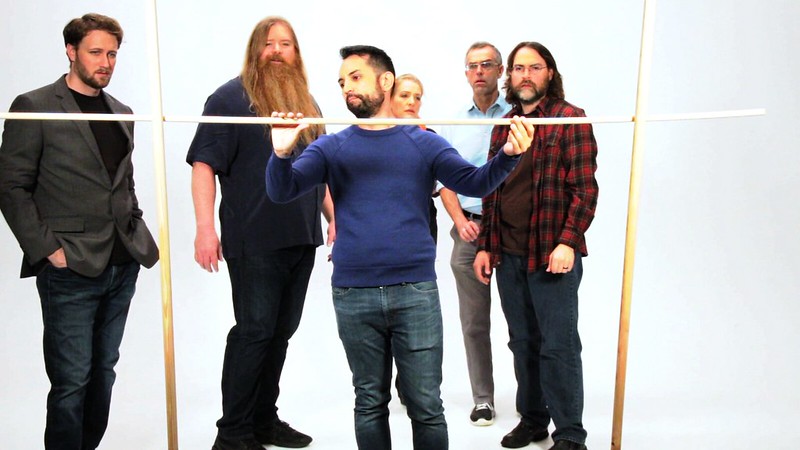 They don't know what it is until Alexis realizes/decides it's a limbo game. I originally thought he recognized it for what it was, but as I was editing I realized that I'd try to play it like he decisively imposes a function on it and ergo that's what it becomes. This fits with what happens next wherein they all argue about why the now-a-game is there and what it must mean and what the rules of the game imply to them. Again, originally I thought about this being more literal (the game is the exit) but in editing decided it was more interesting if I played it more like the characters seize upon the idea that it must be the way out and thus it becomes that... the logjam breaker. The blocking and angles suggest this even though that's not necessarily what I planned while shooting.
They don't know what it is until Alexis realizes/decides it's a limbo game. I originally thought he recognized it for what it was, but as I was editing I realized that I'd try to play it like he decisively imposes a function on it and ergo that's what it becomes. This fits with what happens next wherein they all argue about why the now-a-game is there and what it must mean and what the rules of the game imply to them. Again, originally I thought about this being more literal (the game is the exit) but in editing decided it was more interesting if I played it more like the characters seize upon the idea that it must be the way out and thus it becomes that... the logjam breaker. The blocking and angles suggest this even though that's not necessarily what I planned while shooting.
MAKING WHERE SOMETHING IS IN THE FRAME TELLS US WHAT A CHARACTER FEELS
 This shot is about Rowan's POV, as he sees this thing as a threat to his comfortable status quo, ergo I framed the shots so the bar height suggests clotheslining/slashing across their throats, albeit this was tricky given the different heights of the two actors. I probably should have used a quarter apple (box) to cheat Jim (right) up just enough so I could get the bar across the throat of Drew (left) without obscuring Jim behind it.
This shot is about Rowan's POV, as he sees this thing as a threat to his comfortable status quo, ergo I framed the shots so the bar height suggests clotheslining/slashing across their throats, albeit this was tricky given the different heights of the two actors. I probably should have used a quarter apple (box) to cheat Jim (right) up just enough so I could get the bar across the throat of Drew (left) without obscuring Jim behind it.
SIMPLE DOMINANCE IN FRAME
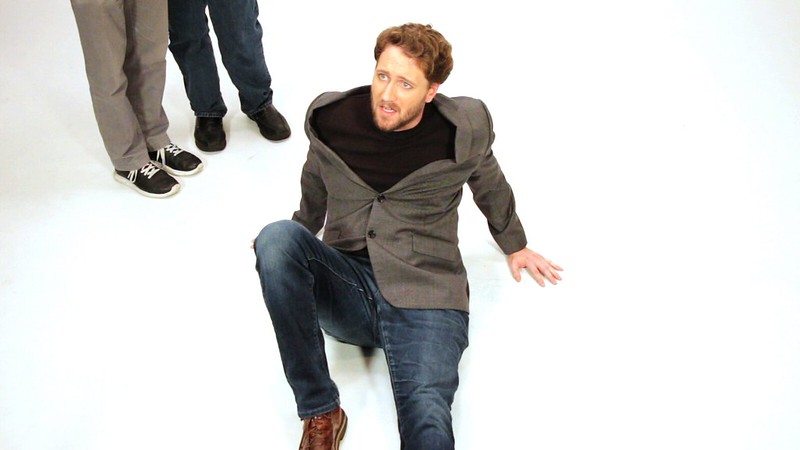
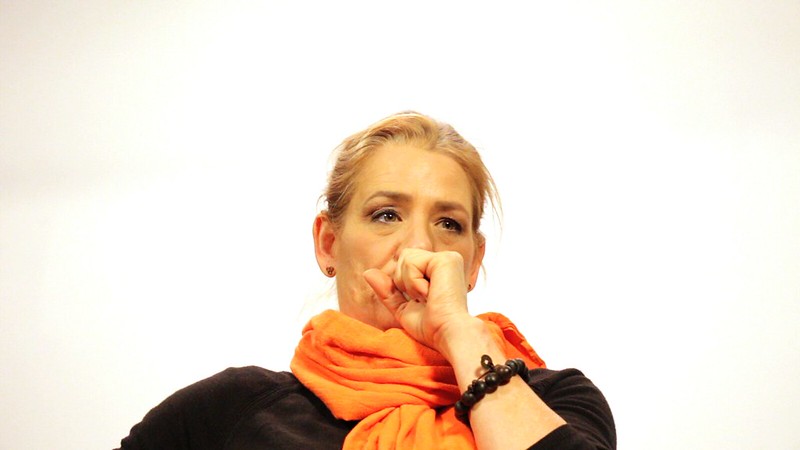 Here are the only places I aimed up or down. I laid on the floor with the camera on my chest to get the up-angle, which not only gives us something like a pseudo-Taylor POV (as he is on the floor), but puts Tracy in a position of power and dominance both in terms of framing and story. So, even though she's unsure at first what to do, the angles reinforce that she has all the cards and the dominant position in the situation.
Here are the only places I aimed up or down. I laid on the floor with the camera on my chest to get the up-angle, which not only gives us something like a pseudo-Taylor POV (as he is on the floor), but puts Tracy in a position of power and dominance both in terms of framing and story. So, even though she's unsure at first what to do, the angles reinforce that she has all the cards and the dominant position in the situation.
THE SIMPLEST EFFECT IS NO EFFECT
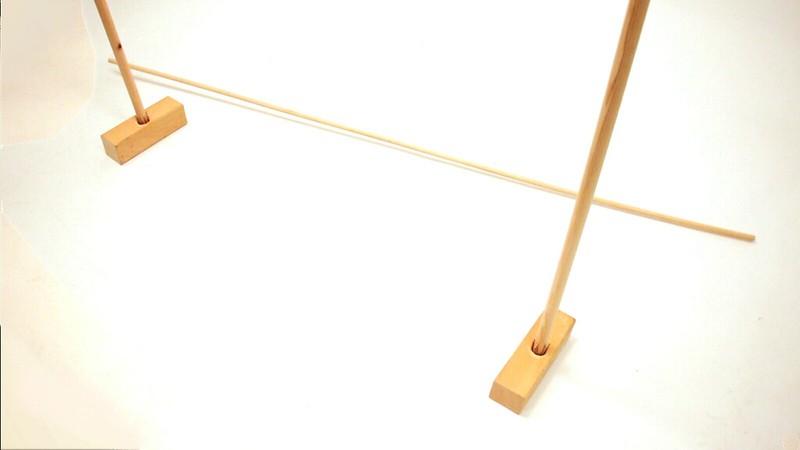 The bar hits the floor. I did this as a down-shot, almost like the POV of someone in the scene. What's important is the sudden absence of the people who just touched it who disappeared in the cut. We don't need to see the mechanics of their exit or a visual effect. The bar clattering to the floor in their wake does the job. Plus, it's delightfully weirder that way.
The bar hits the floor. I did this as a down-shot, almost like the POV of someone in the scene. What's important is the sudden absence of the people who just touched it who disappeared in the cut. We don't need to see the mechanics of their exit or a visual effect. The bar clattering to the floor in their wake does the job. Plus, it's delightfully weirder that way.
BLOCKING AND COMPOSITION AS VISUAL METAPHOR
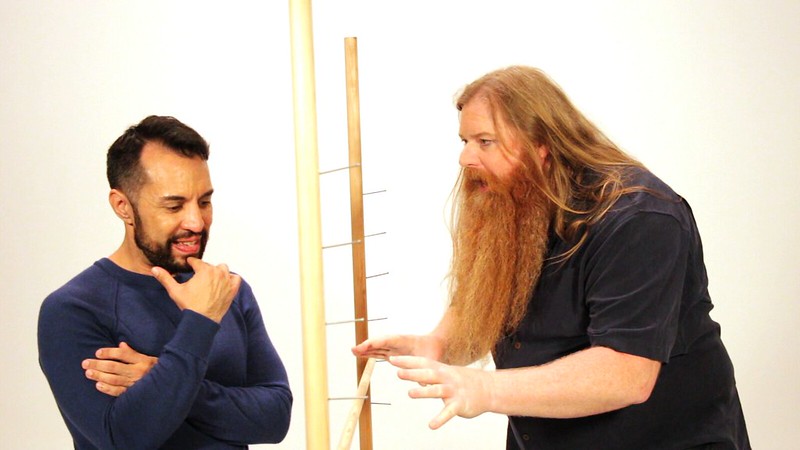 The final confrontations between each couple takes place with the limbo game between them...thus it becomes a sort of physical manifestation of the things that divide them. (I should probably have had the bar in the up and down angles on Tracy and Taylor.)
The final confrontations between each couple takes place with the limbo game between them...thus it becomes a sort of physical manifestation of the things that divide them. (I should probably have had the bar in the up and down angles on Tracy and Taylor.)
But such a shot needn't reinforce what we can see. In fact such a composition can also add a contrasting visual layer to a scene. Imagine two characters playing everything as wonderful and yet there is always something in the shots which stands between them or prevents them from getting close, representing what's really going on behind the facade, or maybe even how they feel even if they are pretending, hiding how they feel, or don't realize their own feelings.
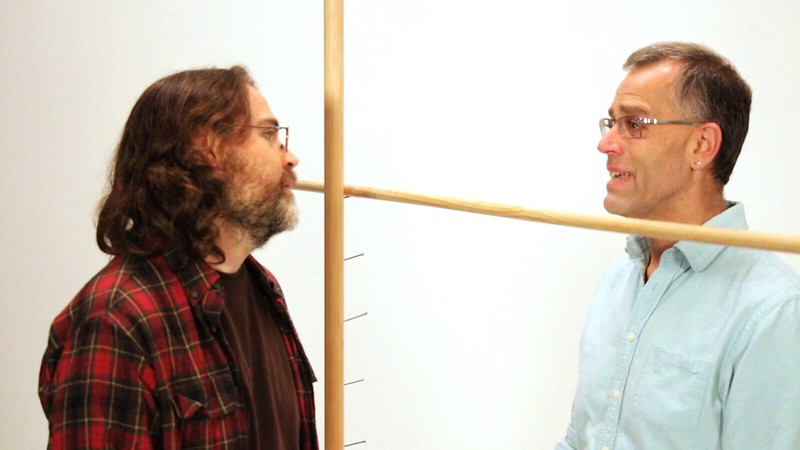 Here, again, the bar at the neck but only in the angles favoring Riley because he's the one who fears change. So it's much more literally across his throat alone. (And, holy crap, look at the raw emotion on his face there. That, my friends, is real acting.)
Here, again, the bar at the neck but only in the angles favoring Riley because he's the one who fears change. So it's much more literally across his throat alone. (And, holy crap, look at the raw emotion on his face there. That, my friends, is real acting.)
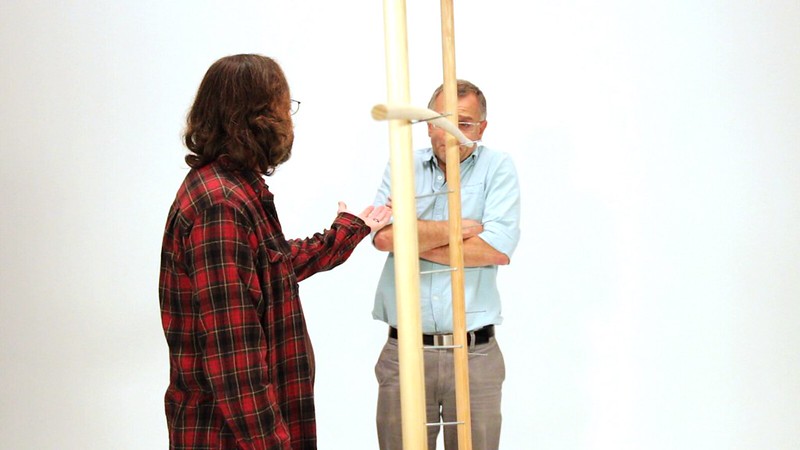 Here near the finish I let Riley be obscured by the limbo game because he literally feels lost behind it. I probably should have not had him so directly behind it as I did, though. I should have moved him a hair to screen left and the camera a few inches to the right and cranked it up one hand higher so his face was framed/pinned between the vertical posts.
Here near the finish I let Riley be obscured by the limbo game because he literally feels lost behind it. I probably should have not had him so directly behind it as I did, though. I should have moved him a hair to screen left and the camera a few inches to the right and cranked it up one hand higher so his face was framed/pinned between the vertical posts.
Now, the nature of the film and the limitations of the set suggests stillness and that could be visually dull, so I decided to create contrasting movement in Beckett/god's second appearance. A common mistake of novice filmmakers is trying to make things busy or contain action merely for visual interest but oftentimes that is counter-productive because if the action and/or camera moves are not "motivated" they might undermine or contradict the intent of the scene rather than support or counterpoint it.


Notice also that the limbo people never actually make eye contact with Beckett. I instructed them to do this so to suggest that either they can't see or are ignoring her... without specifying which it is. You choose.
VISUAL SYMBOLISM WITH A SIMPLE PROP



MAKING WHERE SOMETHING IS IN THE FRAME TELLS US WHAT A CHARACTER FEELS

SIMPLE DOMINANCE IN FRAME


THE SIMPLEST EFFECT IS NO EFFECT

BLOCKING AND COMPOSITION AS VISUAL METAPHOR

But such a shot needn't reinforce what we can see. In fact such a composition can also add a contrasting visual layer to a scene. Imagine two characters playing everything as wonderful and yet there is always something in the shots which stands between them or prevents them from getting close, representing what's really going on behind the facade, or maybe even how they feel even if they are pretending, hiding how they feel, or don't realize their own feelings.


SIMPLE SYMBOLISM

A quick edit to add...
HEAD SPACE
Look back at the frames above and notice that—except for the up angle on Tracy where I want to suggest the limbo goes up forever—no actor's head is ever vertically centered in the frame. Generally their heads are positioned in the upper half of the frame. This because the actors are the focus, not the set (especially not on one this empty). The natural instinct is to center on someone's head, and thus in too many fanfilms there's a lot of "big sky" (or bridge monitors) above them, but that's poor composition.
I hope this demonstrates how much value simple blocking and camera placement can add to your films for basically no cost but some forethought.
Quick Coda
Given how quickly we shot this there are blocking issues I had difficulty with. Trying to get six actors to hit their marks around an object without any of them being obscured proved difficult and I would have liked to have gotten more takes of the wide shots to improve this, plus some additional coverage to be able to intercut with. But, fortunately, the actors were good enough where they could play four pages in one take and the energy and the performances were strong enough to make it work even if they occasionally got somewhat obscured (and, frustratingly, the focus got knocked slightly during some of this, which resulted in said shots being a little soft).
One other little bit of blocking/action that was seat-of-pants was the immovable nature of the limbo bar. In the script Adrian was supposed to grab the bar and find it would not budge. Well, it turned out that the limbo prop as delivered was really wobbly, and if you actually touched the bar the poles would tend to move, which looked bad. So we tried to cheat it so it appeared Erik Braa closed his hands around the bar without actually doing so, but that looked unconvincing. Someone—maybe Erik—suggested that there's some magnetic force or something which doesn't let you grab it. So that's what we did, and it made it a little more unreal. The sound effect of the repulsive force is the icing on the cake.
Last edited:
Maurice, I don't think I've said it yet, but thank you for posting these. They are very helpful in understanding the "how" and "why" involved in making a film.
Hey thanks. That's nice to hear. I do these not to toot my own horn but in a genuine effort to be helpful, which I hope is apparent inasmuch as I admit where I've made mistakes.Maurice, I don't think I've said it yet, but thank you for posting these. They are very helpful in understanding the "how" and "why" involved in making a film.
Oh, I meant to add I gave all the characters unisex names and let the actors pick their parts when they arrived on-set, so I had no preconception of any of these characters as gendered. The only actor I deliberately cast was Beckett/god, because she was only available for half the day and that character only appeared in two scenes, so it was casting by necessity... albeit she's always wonderful so I have no complaints.
And "Beckett" was named such after my writing partner said the concept was a bit Waiting for Godot-ish, and as playwrights are effectively God to their characters, I decided to name my "God" after Godot scribe Samuel Beckett.
And "Beckett" was named such after my writing partner said the concept was a bit Waiting for Godot-ish, and as playwrights are effectively God to their characters, I decided to name my "God" after Godot scribe Samuel Beckett.

CAMERA STABILIZATION IN REACH OF NEXT-TO-NO-BUDGET FILMMAKING
Check out this video I shot today in the Internet Archive using an iPhone running Filmic Pro at a capture rate of 24 frames per second.
What you'll notice immediately is how smooth it is. It's totally handheld, but the camera is almost always level (horizontally) and no matter where I go or how I swing it around, or even if I snap it around 180° the pivots are really smooth.
This is because my iPhone was mounted on an OMSO Mobile One, which is basically a powered gimbal-lock for mobile phones that allows you to use them much like a Steadicam. It has powered pan and tilt, the ability to lock angle even as you twist and turn, and the ability to immediately auto-level and recenter just by double-pressing the trigger. And this particular gizmo goes for a measly $130, and it makes really professional looking what otherwise would be sloppy jerky handheld. I didn't even try to walk carefully or anything while shooting this.
Here's a much shorter video I just shot using it, where I walk up to a mirror so you can see the device in action.
Such devices are available for Digital SLRs and other cameras, but as those are much larger and heavier the gimbal-lock devices are proportionally more expensive for those as opposed to a phone.
But Steven Soderbergh is shooting movies on iPhones (see the trailer for Unsane here). The combination of software like Filmic Pro and devices like this make smartphones an actually viable solution for a lot of low-end bare-bones filmmakers.
Check out this video I shot today in the Internet Archive using an iPhone running Filmic Pro at a capture rate of 24 frames per second.
What you'll notice immediately is how smooth it is. It's totally handheld, but the camera is almost always level (horizontally) and no matter where I go or how I swing it around, or even if I snap it around 180° the pivots are really smooth.
This is because my iPhone was mounted on an OMSO Mobile One, which is basically a powered gimbal-lock for mobile phones that allows you to use them much like a Steadicam. It has powered pan and tilt, the ability to lock angle even as you twist and turn, and the ability to immediately auto-level and recenter just by double-pressing the trigger. And this particular gizmo goes for a measly $130, and it makes really professional looking what otherwise would be sloppy jerky handheld. I didn't even try to walk carefully or anything while shooting this.
Here's a much shorter video I just shot using it, where I walk up to a mirror so you can see the device in action.
Such devices are available for Digital SLRs and other cameras, but as those are much larger and heavier the gimbal-lock devices are proportionally more expensive for those as opposed to a phone.
But Steven Soderbergh is shooting movies on iPhones (see the trailer for Unsane here). The combination of software like Filmic Pro and devices like this make smartphones an actually viable solution for a lot of low-end bare-bones filmmakers.
Last edited:
Your bathroom mirrors are SPOTLESS! Impressed!CAMERA STABILIZATION IN REACH OF NEXT-TO-NO-BUDGET FILMMAKING
Check out this video I shot today in the Internet Archive using an iPhone running Filmic Pro at a capture rate of 24 frames per second.
What you'll notice immediately is how smooth it is. It's totally handheld, but the camera is almost always level (horizontally) and no matter where I go or how I swing it around, or even if I snap it around 180° the pivots are really smooth.
This is because my iPhone was mounted on an OMSO Mobile One, which is basically a powered gimbal-lock for mobile phones that allows you to use them much like a Steadicam. It has powered pan and tilt, the ability to lock angle even as you twist and turn, and the ability to immediately auto-level and recenter just by double-pressing the trigger. And this particular gizmo goes for a measly $130, and it makes really professional looking what otherwise would be sloppy jerky handheld. I didn't even try to walk carefully or anything while shooting this.
Here's a much shorter video I just shot using it, where I walk up to a mirror so you can see the device in action.
Such devices are available for Digital SLRs and other cameras, but as those are much larger and heavier the gimbal-lock devices are proportionally more expensive for those as opposed to a phone.
But Steven Soderbergh is shooting movies on iPhones (see the trailer for Unsane here). The combination of software like Filmic Pro and devices like this make smartphones an actually viable solution for a lot of low-end bare-bones filmmakers.
Oh, and the videos are cool.
The OSMO is device agnostic. However, there is a piece of software that allows you to customize the controls and the website says:
As to the bathroom mirror, I'll compliment the housekeeper.
2. The shooting capabilities of the Osmo Mobile depend on what type of mobile phone system you use. Consequently, Android users may not be able to use the fully optimized functions of the Osmo Mobile. DJI is working with Android phone manufacturers to provide a better user experience to all Android users. Thank you for your patience and understanding.
As to the bathroom mirror, I'll compliment the housekeeper.

Giving Yourself Permission To Fail
As per some posts above, last year my birthday was celebrated by making the short film The Limbo Set, which was designed around the limitations of shooting on a white cyclorama/limbo set with no "set", a single prop, and iterations on variations on "limbo". We had so much fun making it many of the cast and crew asked if we were going to do it again, so yesterday we did, shooting a short subject titled Afterglow.
The main rule I have with these things is to "give myself permission to fail", which frees me up to experiment. If it train-wrecks, it train-wrecks, but I'll learn more by pushing into the unknown than if I do what comes natural. One thing I love to do is impose limitations on myself and see how creative I can be inside the confines of that box. I think such a thing is valuable because it forces you to step outside your comfort zone and—succeed or fail—you learn how to be a better filmmaker.
My self-imposed limitations this year were:
Digital slate meets epic beard.
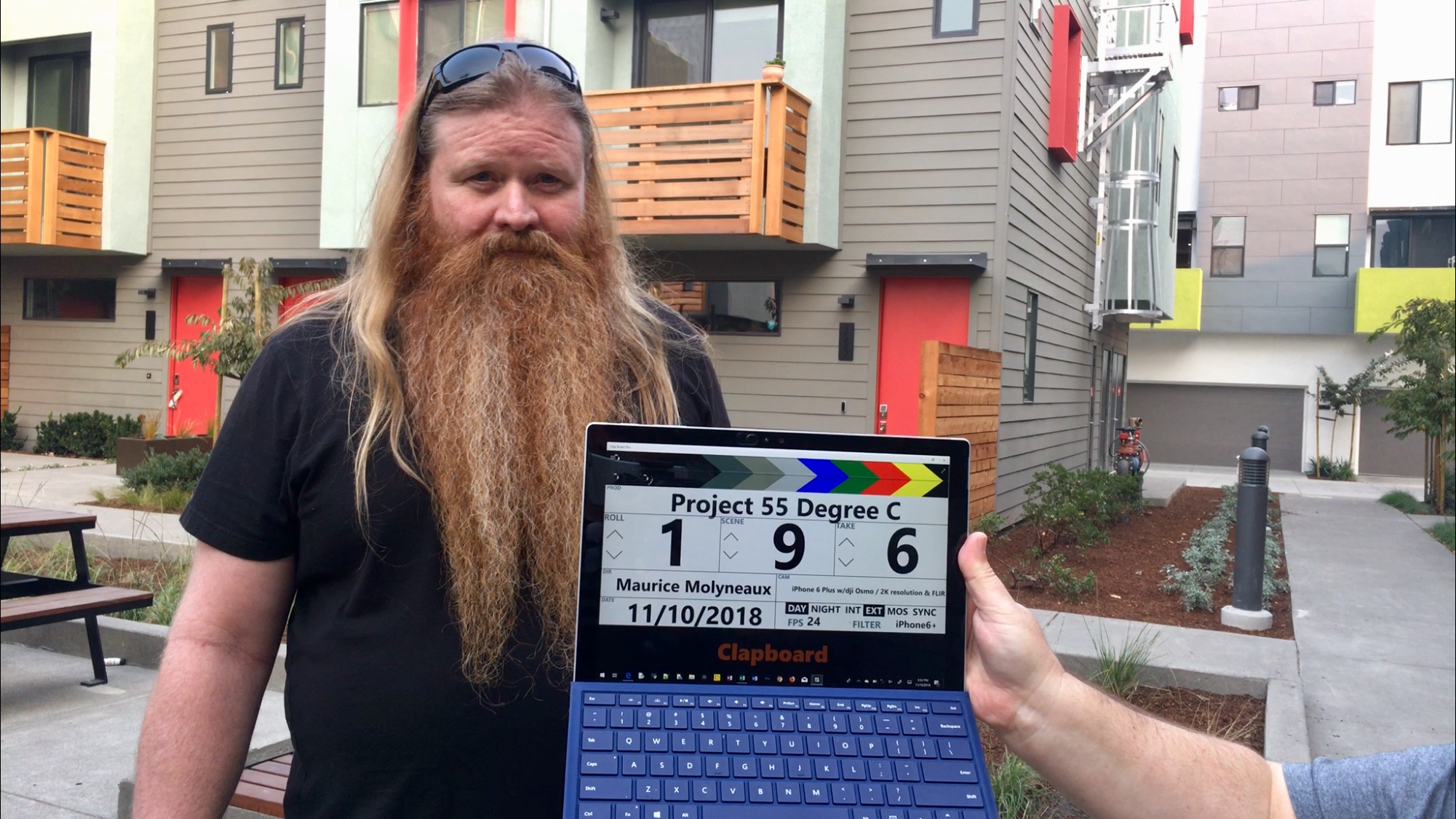
Frank Christian Marx (IMDb link) reads dialog so Philip Foster can get a a sound level. I was doing camera tests and messing with aspect ratios and settings during this.
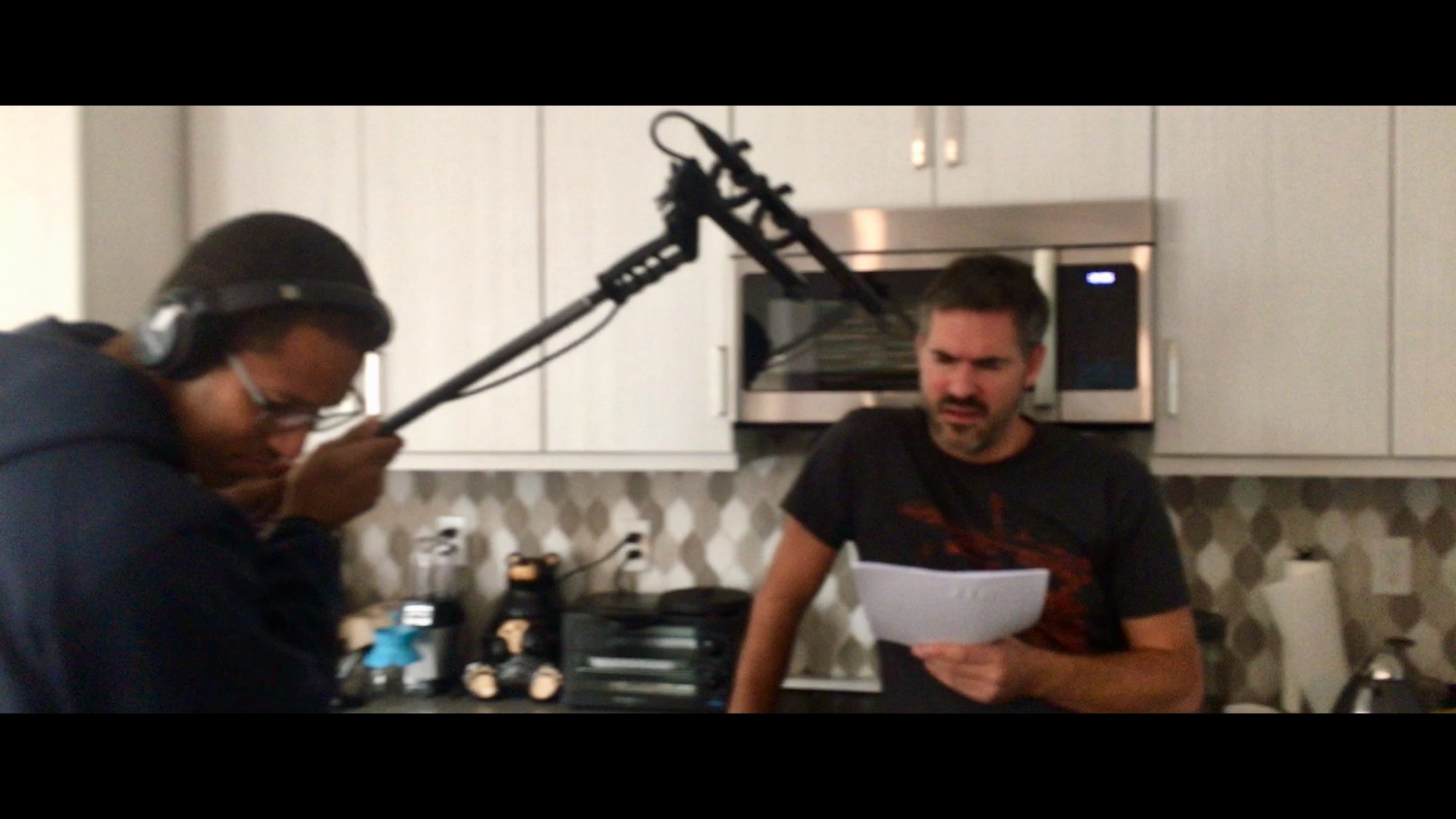
One of the takes where the focus got mushy.
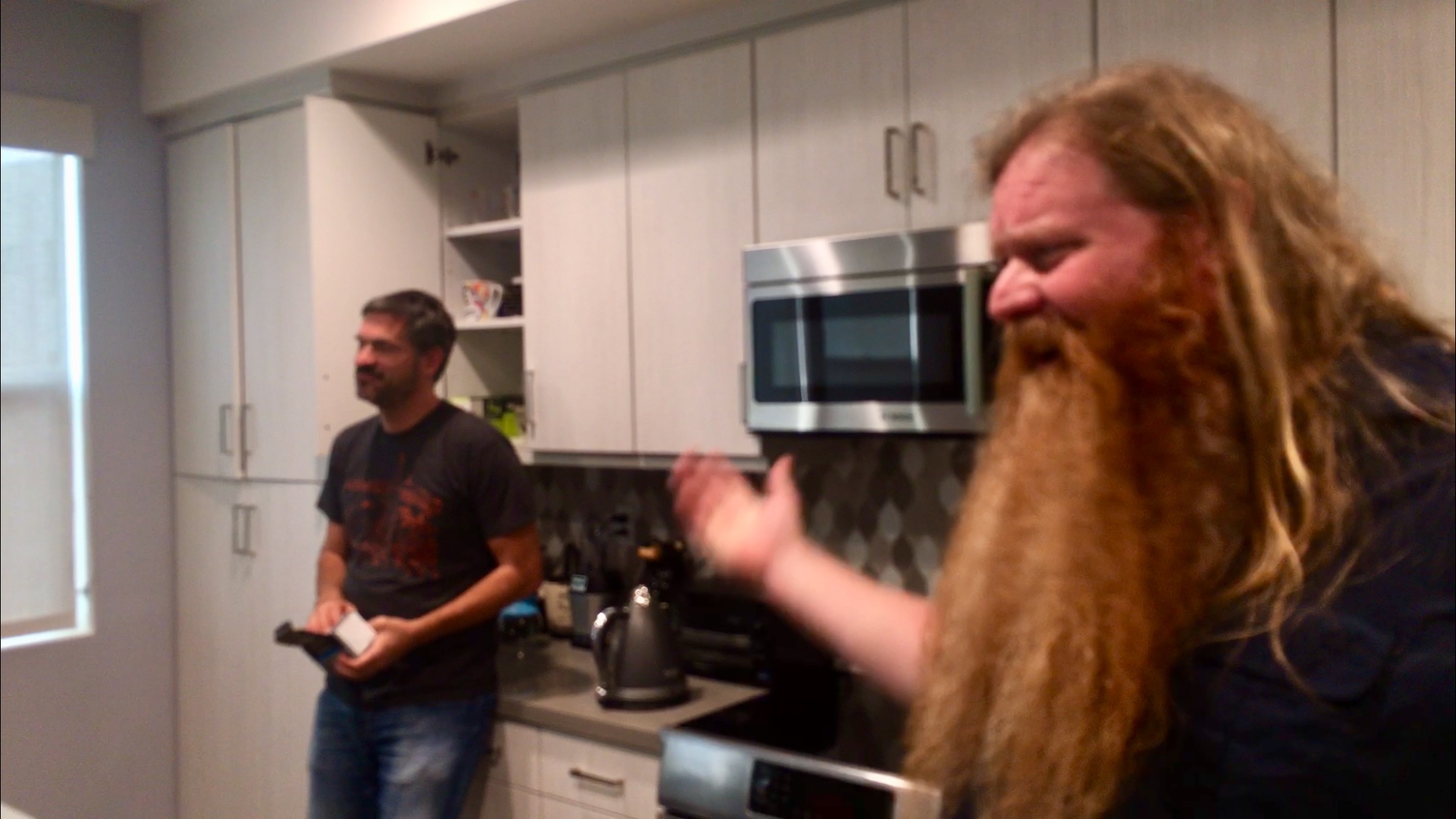
The Portland Oregon location...

...and Kyle's eyeline on the iPad where Frank appears.
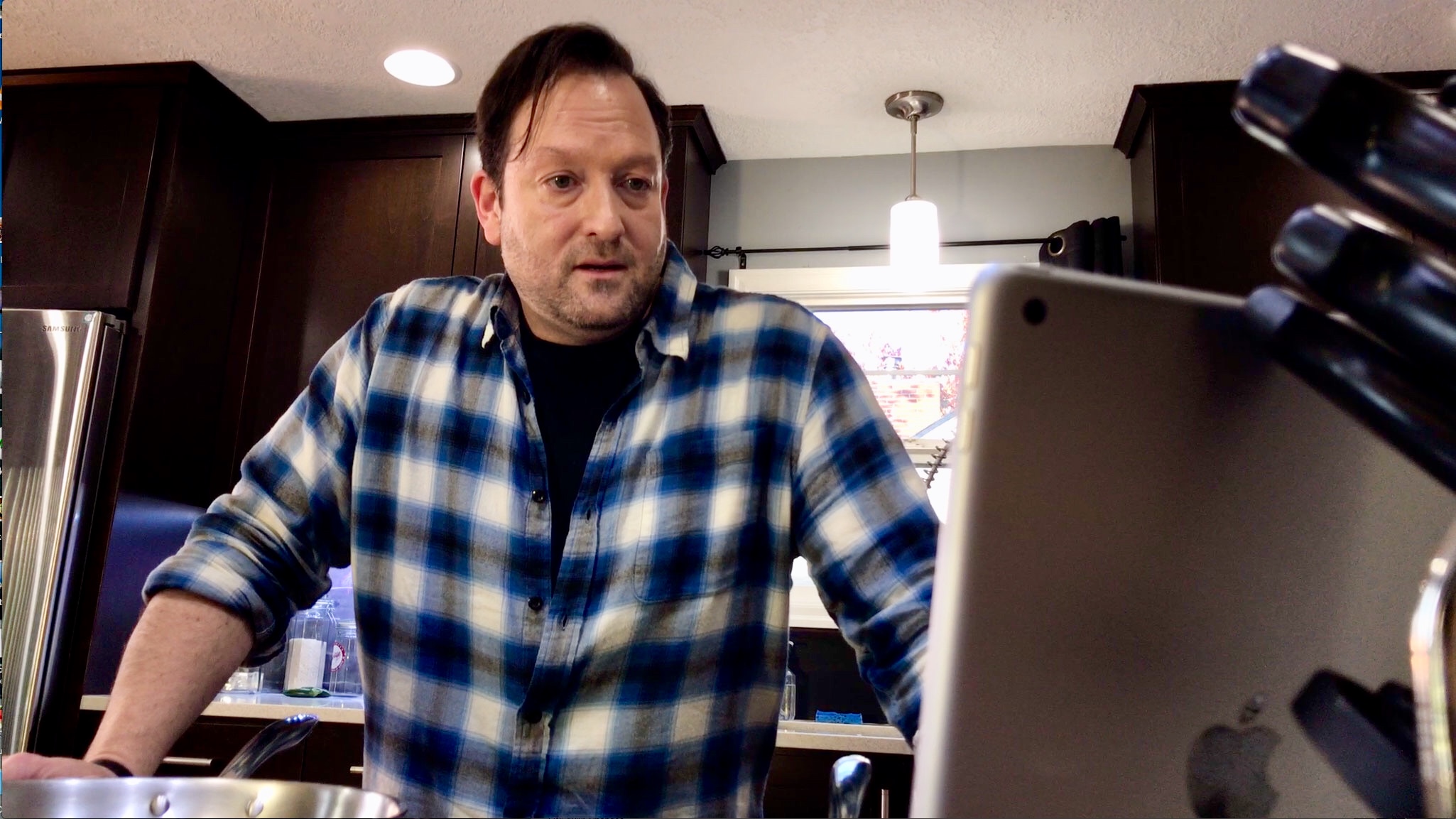
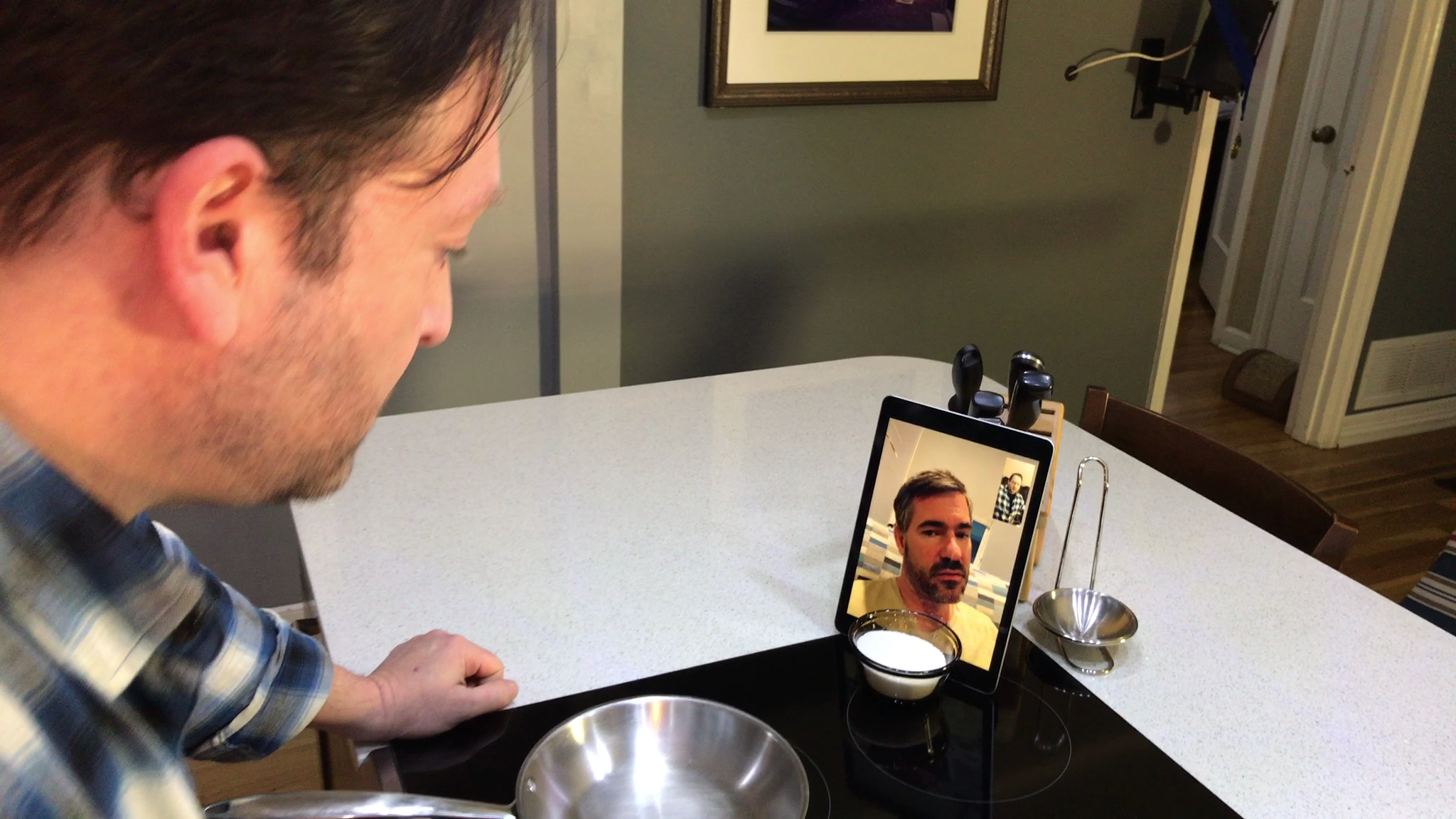
Simultaneous shoot from 600 miles away: Frank interacts with Kyle over a live Facetime call. Long-distance acting! Video lag was a slight issue but since this is the one scene shot with coverage—OTS (over-the-shoulder), wide, medium, CU (close-up) this can be dealt with easily enough. This is no Starfleet Admiral space-Skype chat, this is the most intimate scene of the piece, so the camera moves very little to reflect the mood.
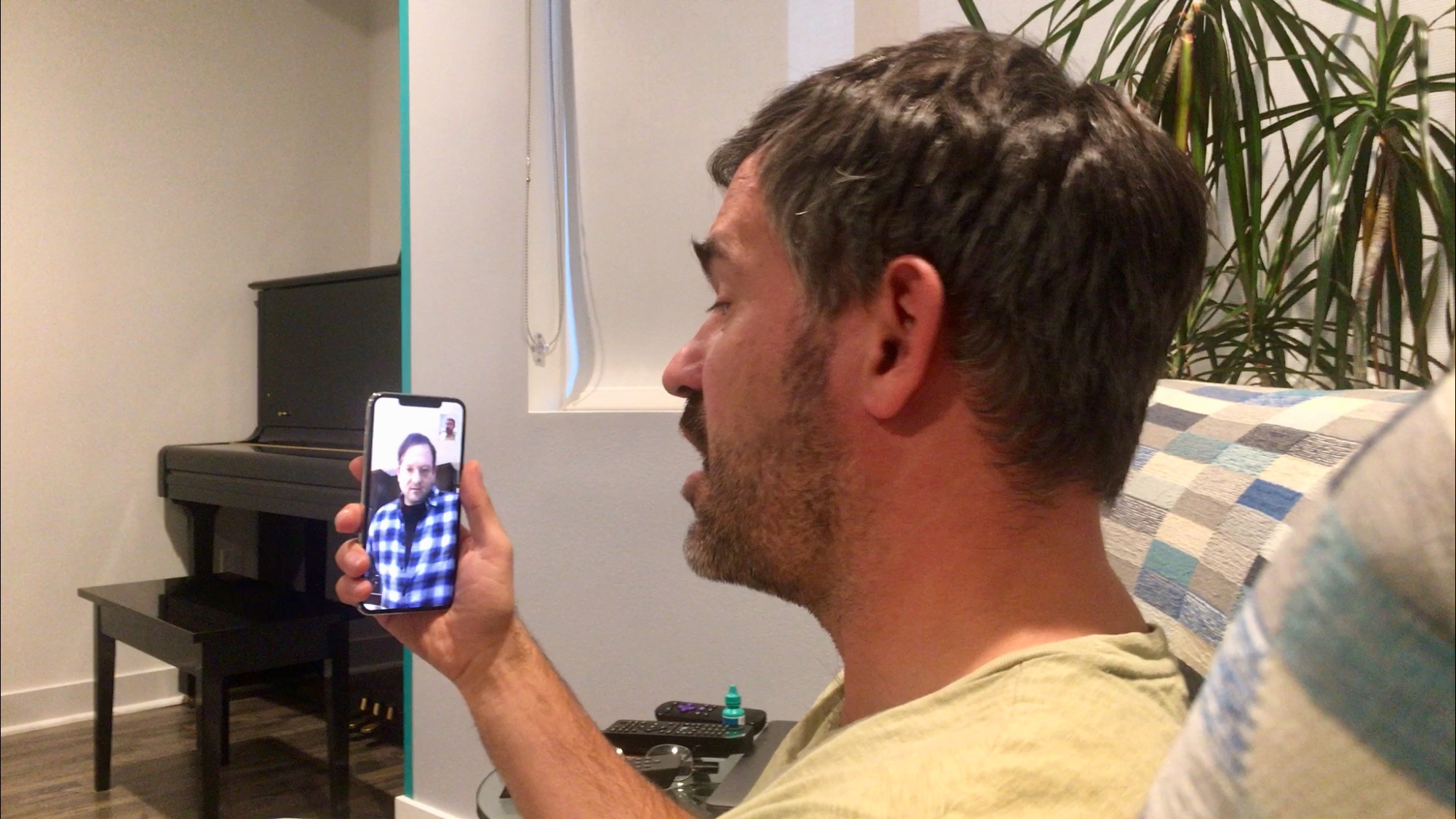
...notice we maintain the 180° rule and don't Cross the Line even here!
More handheld stuff! I stood on the bed and started the shot close to Frank's face, then raised the camera until I could see the whole width of the bed to show how alone he feels.

His POV using infrared thermography to represent the titular "Afterglow" of a person who has left.
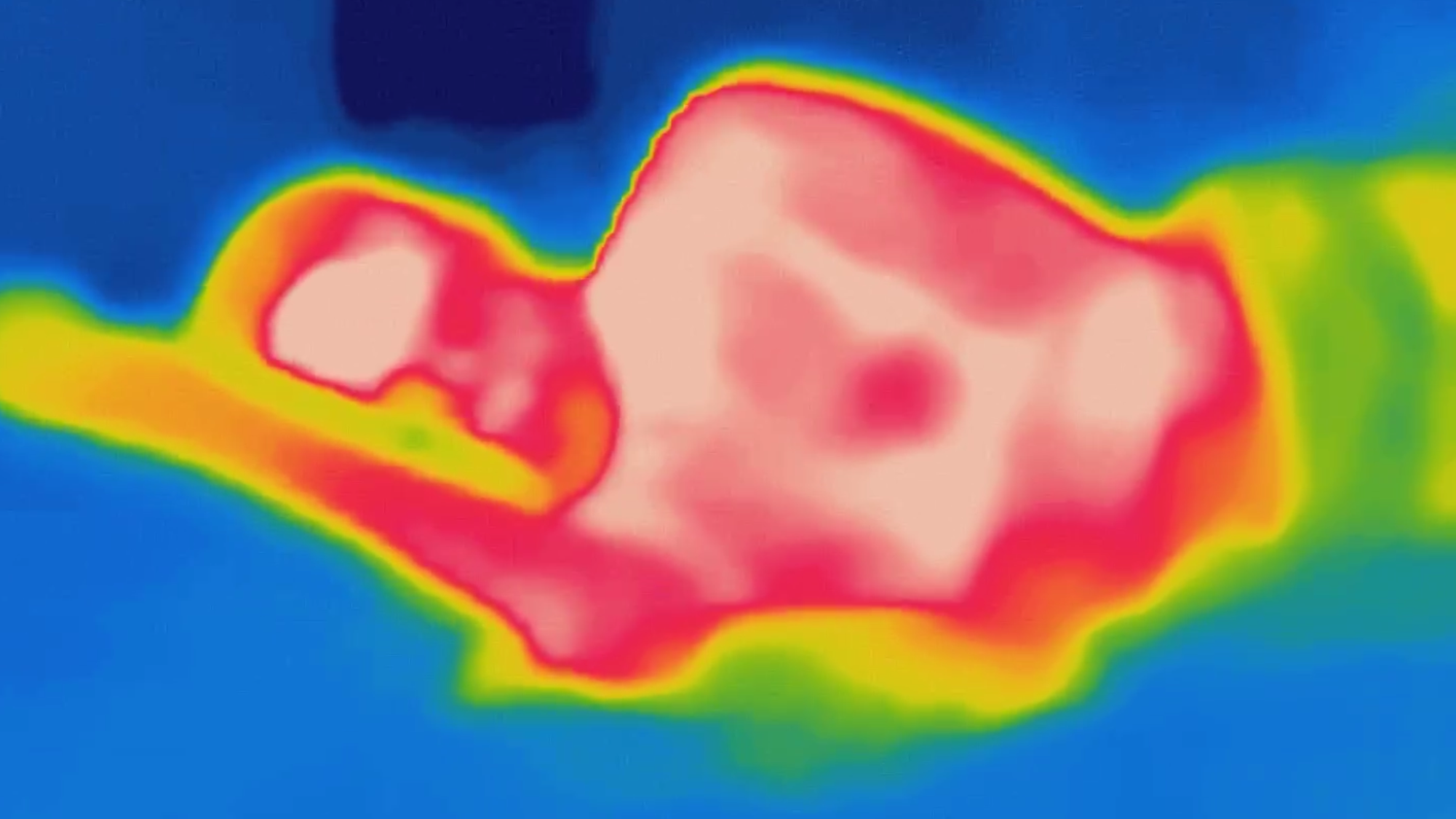
A walk & talk one-er wherein I shot it walking backwards over 100 feet each take as the entire scene played out, then reversed direction to push into closeup on Frank as he turns and strides off, outpacing the camera. Here the actors pause for a few lines and I move in and back and forth to follow the dialog.
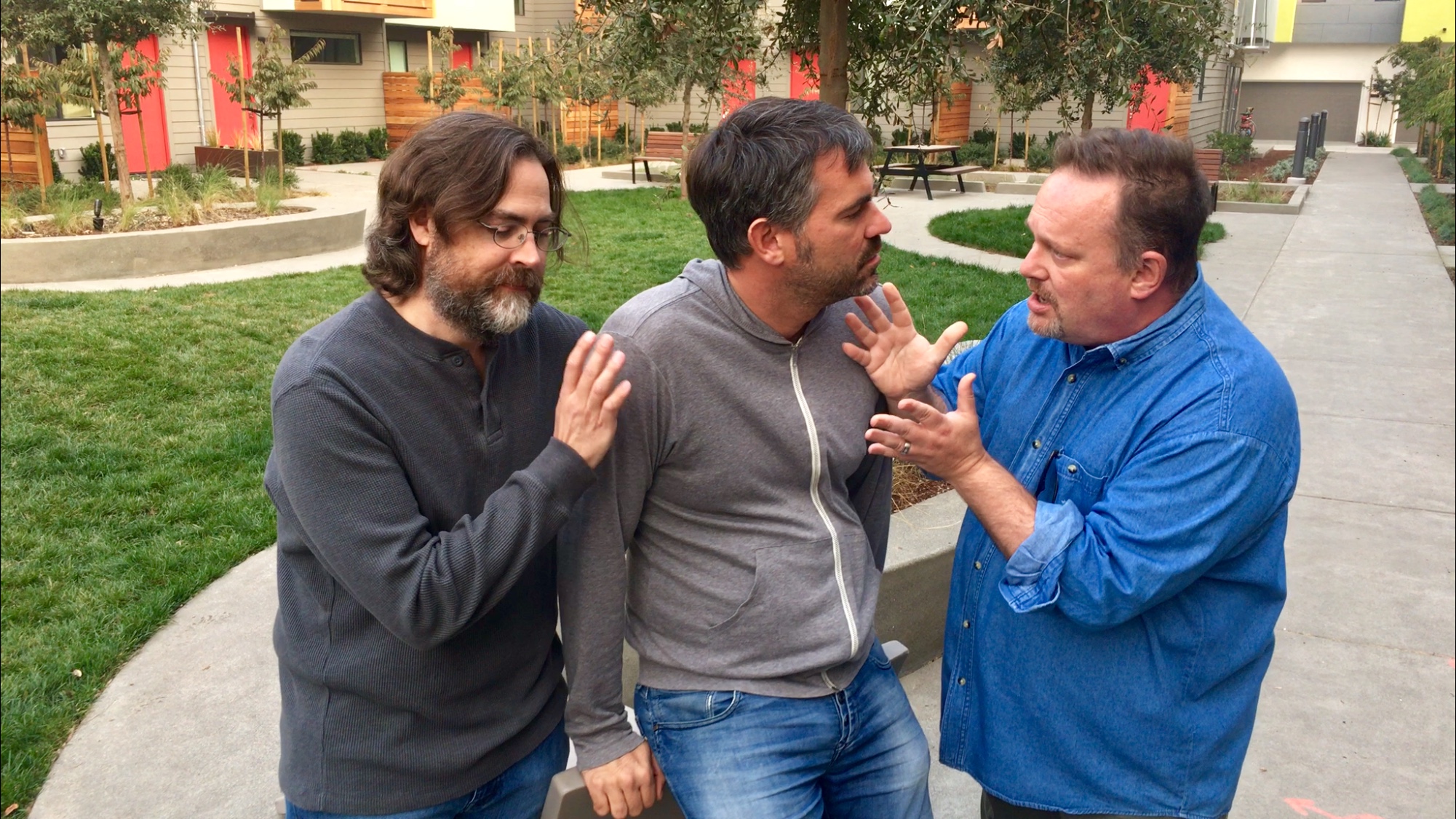
The final scene, which starts looking almost straight down at a board-game...
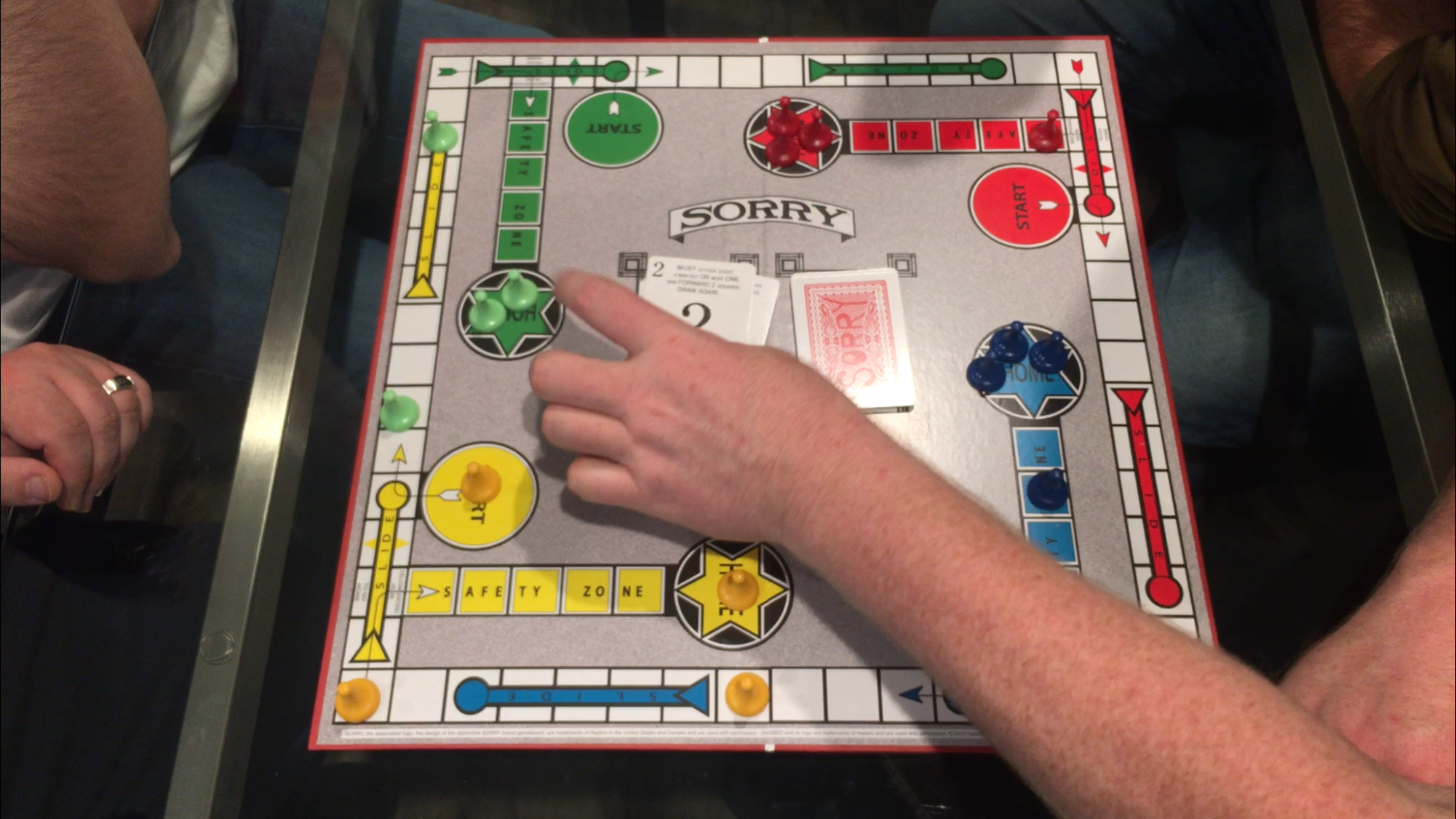
...then , swings level to catch the dialog, as in...
...Erik Braa is not "Sorry!" for winning a game of SORRY. I was whip panning back and forth to both sides of the table to follow the dialog....
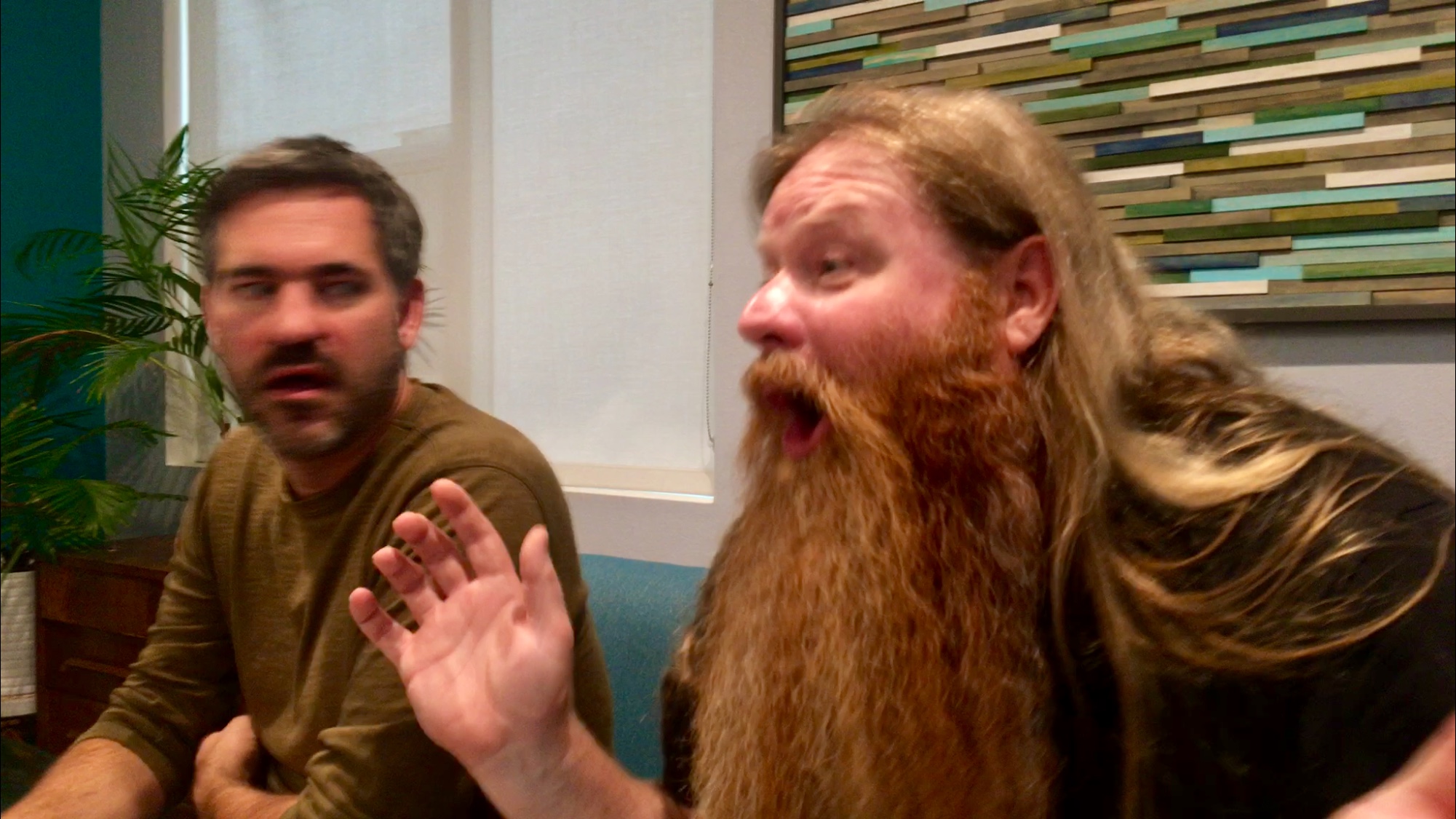
...like back to P.A. Cooley as he ad libs, "I am never playing yellow again. I am not a Piss-Queen!"
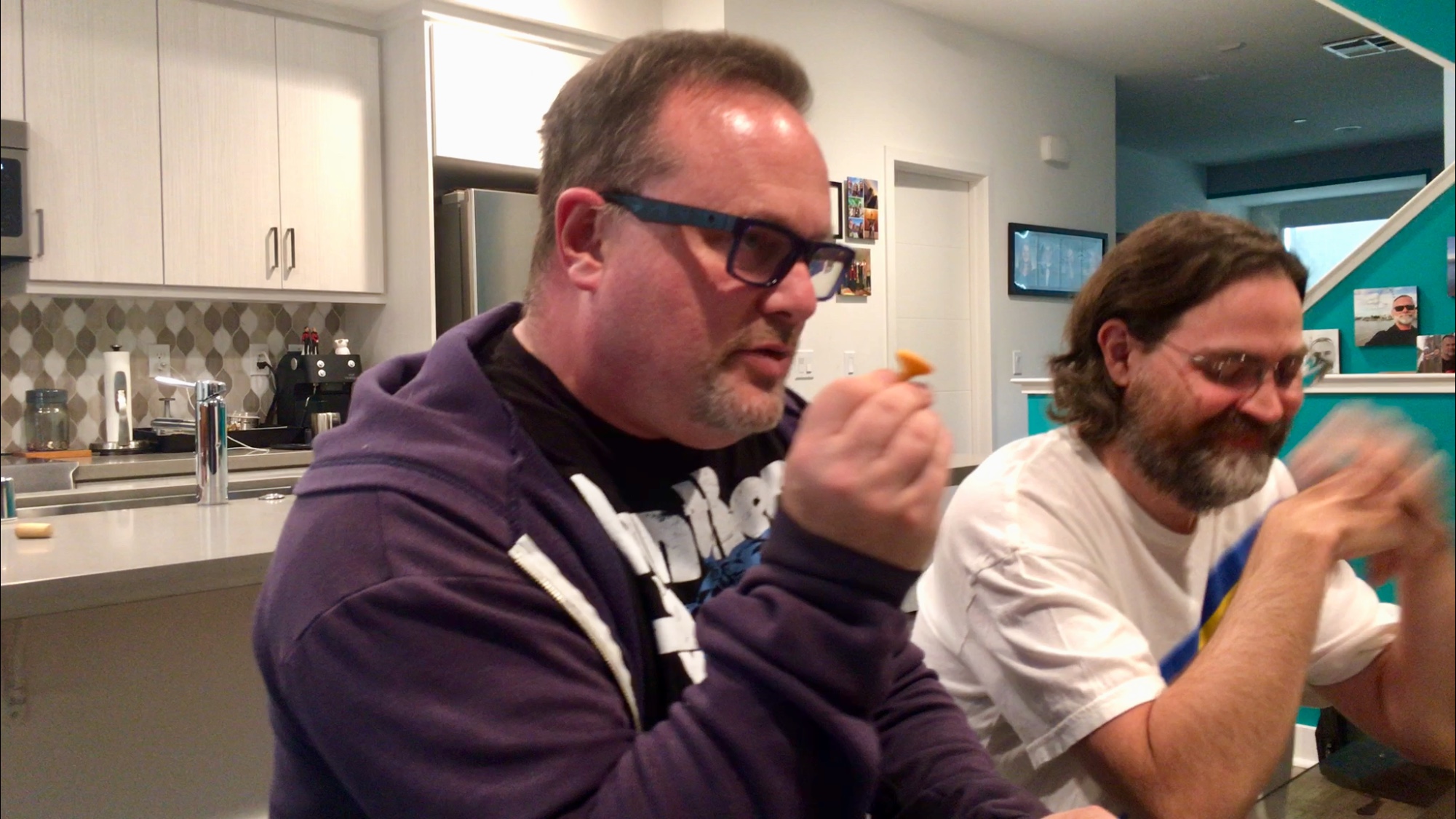
...and eventually follows Frank across the room to the kitchen, then orbits back to the table.
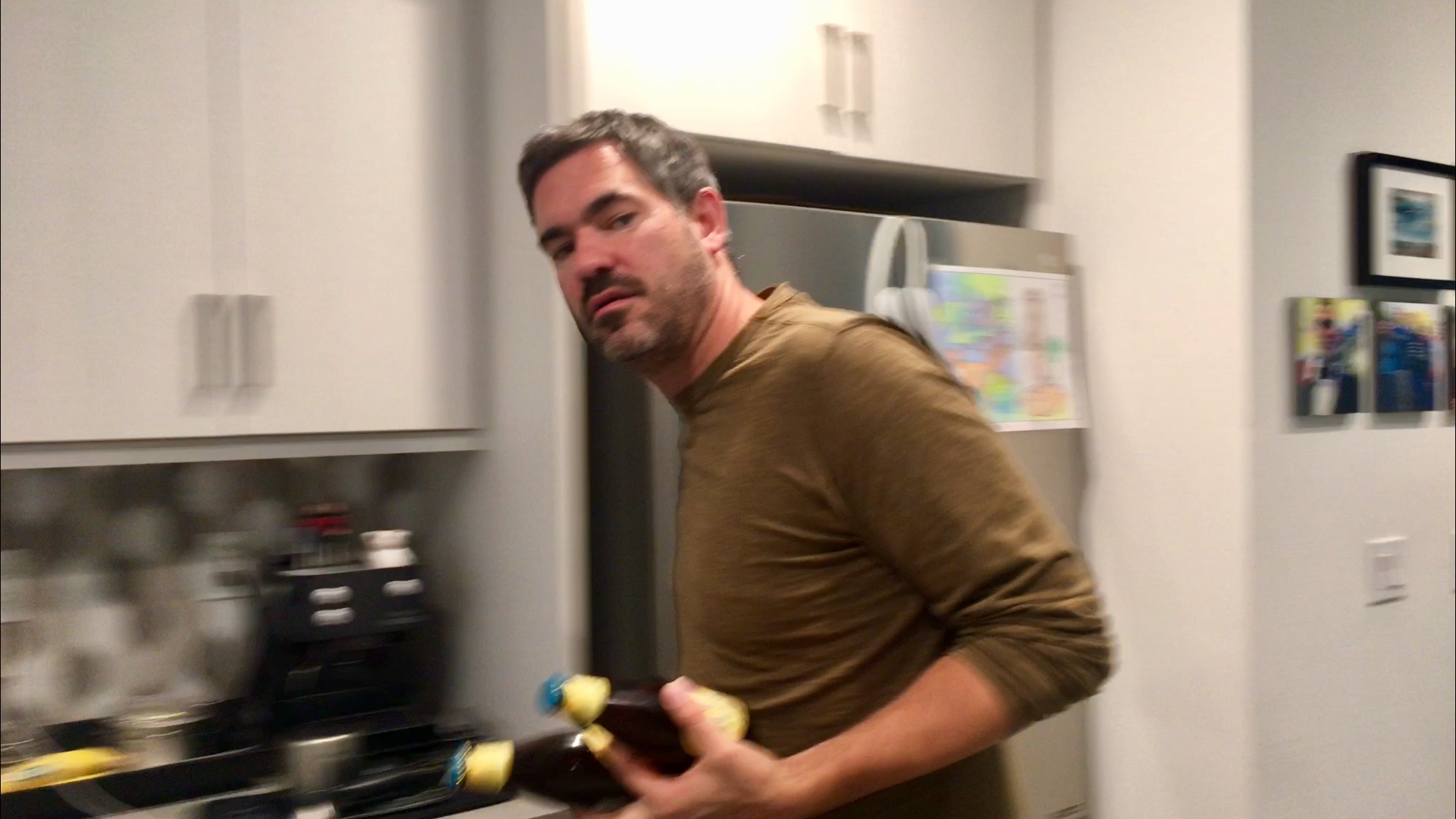
Try doing that with the sound-guy joined to your hip! Frank's shoulder ran into the camera in one take because the clearance was so narrow.
Playback of the the scene as seen on my iPhone as mounted on the OSMO One.
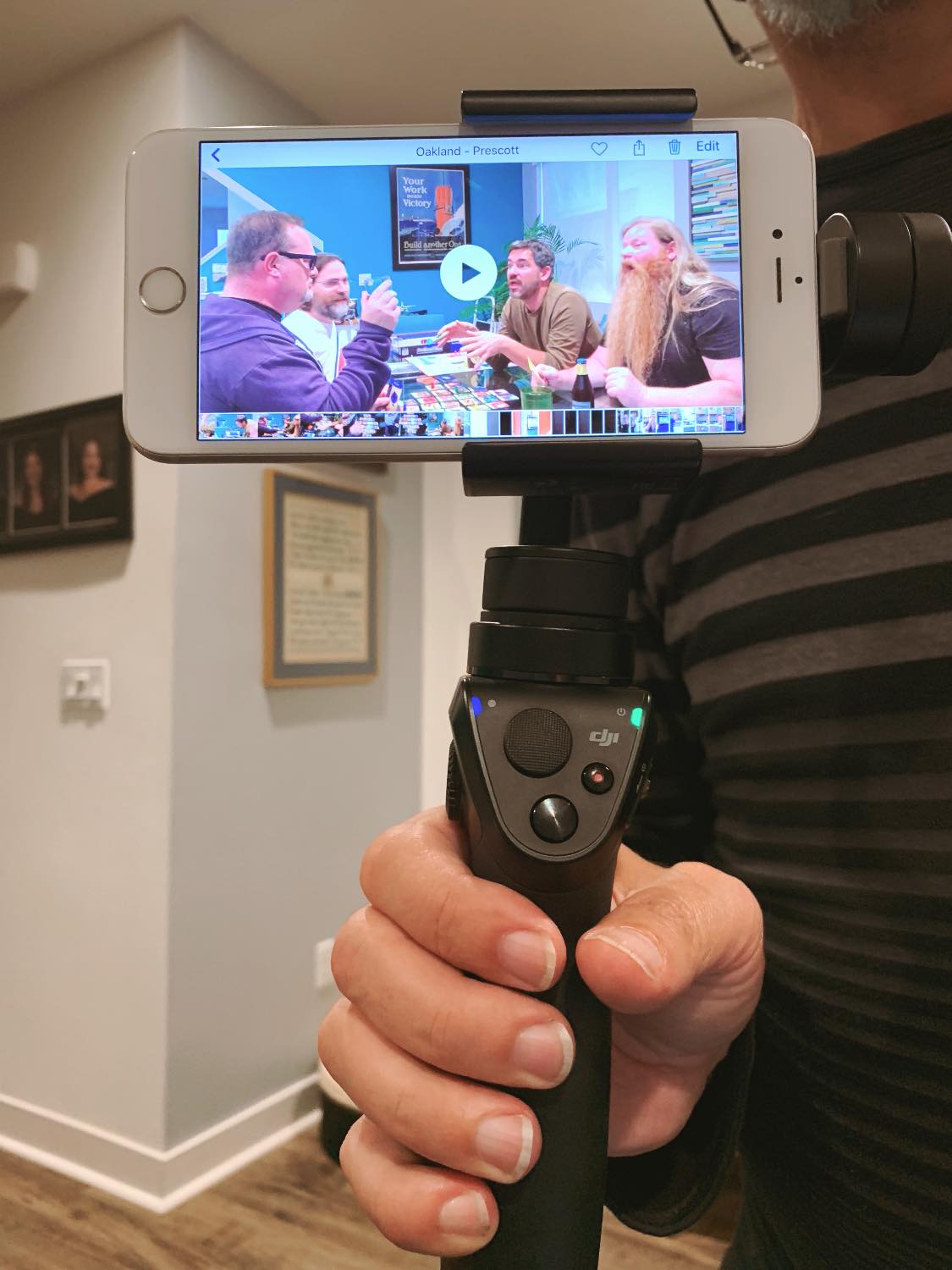
The super-short script with script-supervisor's notes on them.
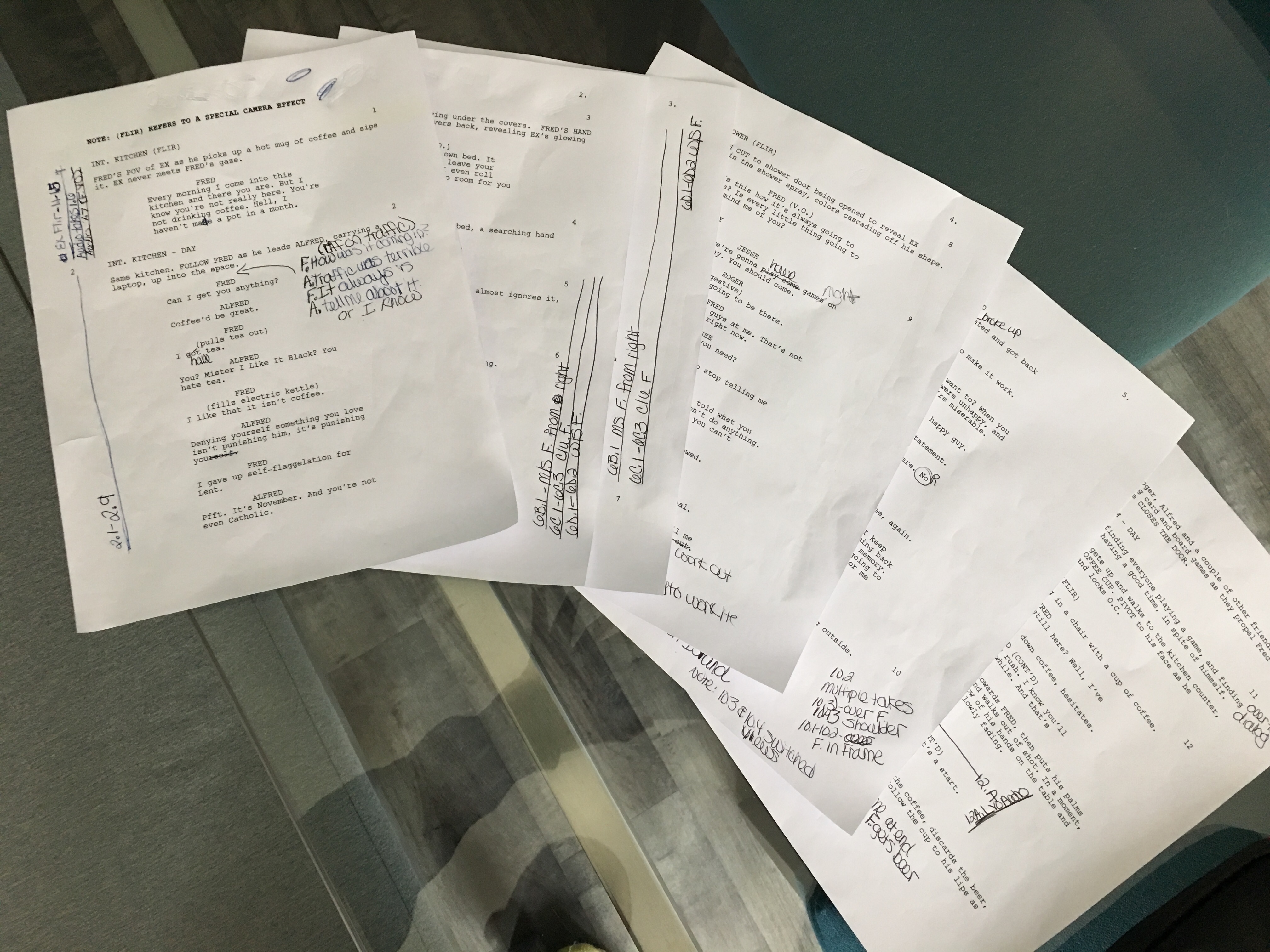
Cast and crew photo. Small team but everyone busted their butts.
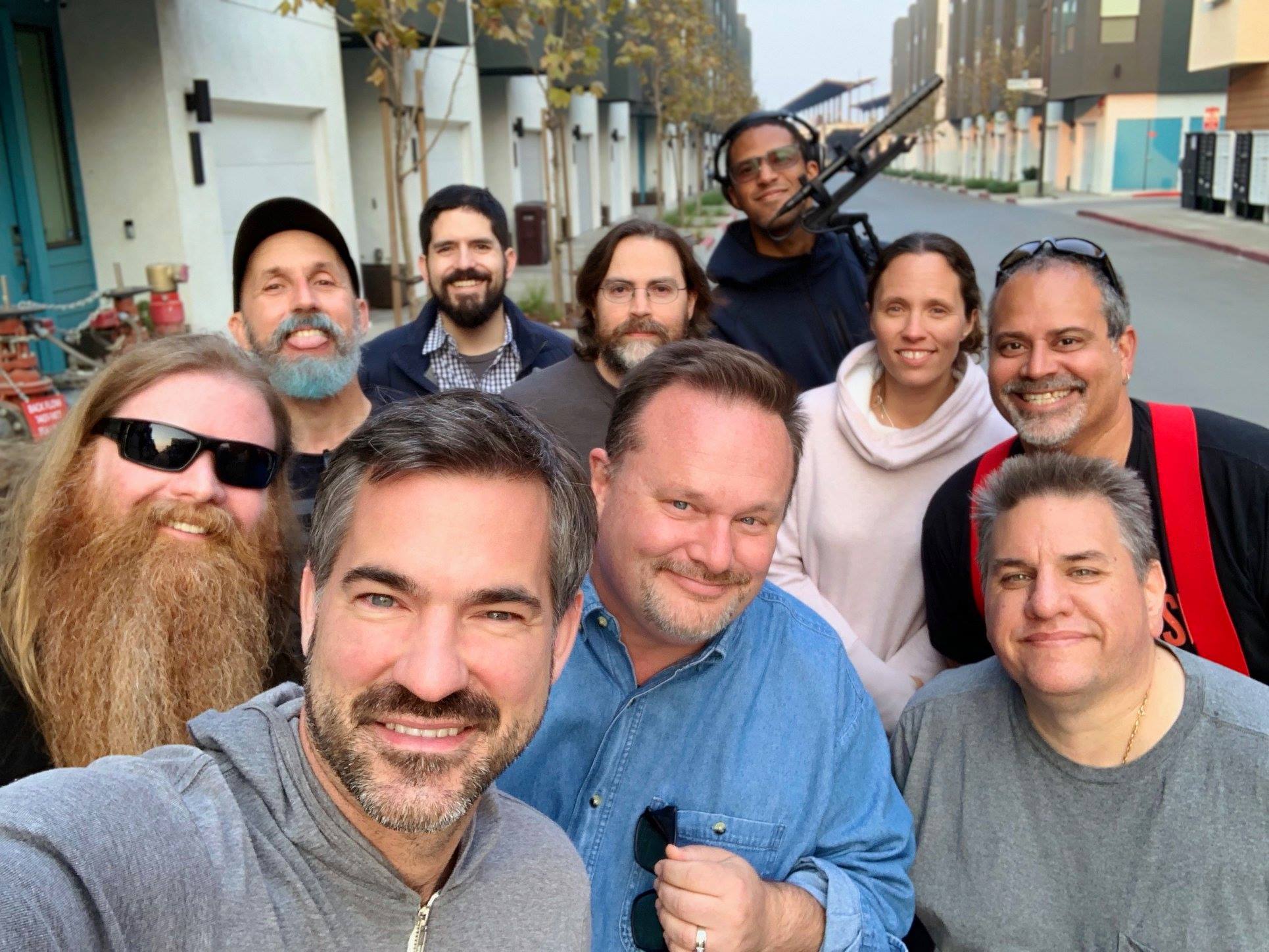
Oh yeah, and they all sang Happy Birthday to me...in key!
More as I work on it...
As per some posts above, last year my birthday was celebrated by making the short film The Limbo Set, which was designed around the limitations of shooting on a white cyclorama/limbo set with no "set", a single prop, and iterations on variations on "limbo". We had so much fun making it many of the cast and crew asked if we were going to do it again, so yesterday we did, shooting a short subject titled Afterglow.
The main rule I have with these things is to "give myself permission to fail", which frees me up to experiment. If it train-wrecks, it train-wrecks, but I'll learn more by pushing into the unknown than if I do what comes natural. One thing I love to do is impose limitations on myself and see how creative I can be inside the confines of that box. I think such a thing is valuable because it forces you to step outside your comfort zone and—succeed or fail—you learn how to be a better filmmaker.
My self-imposed limitations this year were:
- Limit the script to about half the length of the previous shorts I've done (it ended up 6 pages)
- Shoot the entire thing guerrilla-style
- with no grip gear
- on an iPhone
- handheld with a lot of dynamic camera movement using my OSMO One (See CAMERA STABILIZATION IN REACH OF NEXT-TO-NO-BUDGET FILMMAKING above)
- Largely shot as one-ers, meaning single long takes with no coverage to cut to
- Figure out how to utilize my newly acquired infrared thermographic camera for a narrative purpose
- And, finally, how to include TTI director Scott Cummins and Grimm actor Kyle Vahan (IMDb link) in the project even though they are located ~600 miles away in Portland, OR
- Upon reviewing the first scene I realize the focus was a tad mushy and the way I blocked it with the actors required too much camera motion with the result that style of shooting is hurting the scene. Fortunately, both of the actors live on the same block, so getting them back together for 2 hours to reshoot that one scene ought to be easy enough (I hope!).
- At one point I could not find the footage we had shot! It seemed like the software was not writing it out. Fortunately, I figured out where Filmic Pro was writing it to (whew), but what was really sweet was that everyone on the crew said, "If we have to come back and reshoot it we will". Aww.
Digital slate meets epic beard.

Frank Christian Marx (IMDb link) reads dialog so Philip Foster can get a a sound level. I was doing camera tests and messing with aspect ratios and settings during this.

One of the takes where the focus got mushy.

The Portland Oregon location...

...and Kyle's eyeline on the iPad where Frank appears.


Simultaneous shoot from 600 miles away: Frank interacts with Kyle over a live Facetime call. Long-distance acting! Video lag was a slight issue but since this is the one scene shot with coverage—OTS (over-the-shoulder), wide, medium, CU (close-up) this can be dealt with easily enough. This is no Starfleet Admiral space-Skype chat, this is the most intimate scene of the piece, so the camera moves very little to reflect the mood.

...notice we maintain the 180° rule and don't Cross the Line even here!
More handheld stuff! I stood on the bed and started the shot close to Frank's face, then raised the camera until I could see the whole width of the bed to show how alone he feels.

His POV using infrared thermography to represent the titular "Afterglow" of a person who has left.

A walk & talk one-er wherein I shot it walking backwards over 100 feet each take as the entire scene played out, then reversed direction to push into closeup on Frank as he turns and strides off, outpacing the camera. Here the actors pause for a few lines and I move in and back and forth to follow the dialog.

The final scene, which starts looking almost straight down at a board-game...

...then , swings level to catch the dialog, as in...
...Erik Braa is not "Sorry!" for winning a game of SORRY. I was whip panning back and forth to both sides of the table to follow the dialog....

...like back to P.A. Cooley as he ad libs, "I am never playing yellow again. I am not a Piss-Queen!"

...and eventually follows Frank across the room to the kitchen, then orbits back to the table.

Try doing that with the sound-guy joined to your hip! Frank's shoulder ran into the camera in one take because the clearance was so narrow.
Playback of the the scene as seen on my iPhone as mounted on the OSMO One.

The super-short script with script-supervisor's notes on them.

Cast and crew photo. Small team but everyone busted their butts.

Oh yeah, and they all sang Happy Birthday to me...in key!
More as I work on it...
Last edited:
Excellent and informative post Maurice. Thank you for sharing. I wish I wasn’t 5000 miles away. 

Thanks! And me too wishing you were here! I would have cast you!Excellent and informative post Maurice. Thank you for sharing. I wish I wasn’t 5000 miles away.
Here's a raw take from the walk & talk scene shot with the OSMO. I have left the sound off it so the dialog doesn't distract from the visuals. But what I wanted to show y'all is just how much production value this kind of thing adds.
I'd also like to point how just how much the physicality of the actors makes the shot come alive even sans sound. Notice the business they invented with Frank's hood: he is "turtle-ing", defensive, and they keep yanking it down, trying to get him to come out of his shell, and he keeps pulling it back up. They came up with that all on their own while rehearsing and I just added him defiantly pulling it up at the end, implying he's not going to do what they've just told him.
I also added the break where they sit him down for a moment during the serious beat of the conversation and in that moment, by sitting him down, they become more dominant even though he's much taller...thus reinforcing that they're cutting his arguments down to size.
Last edited:
Learning from Technical Difficulties
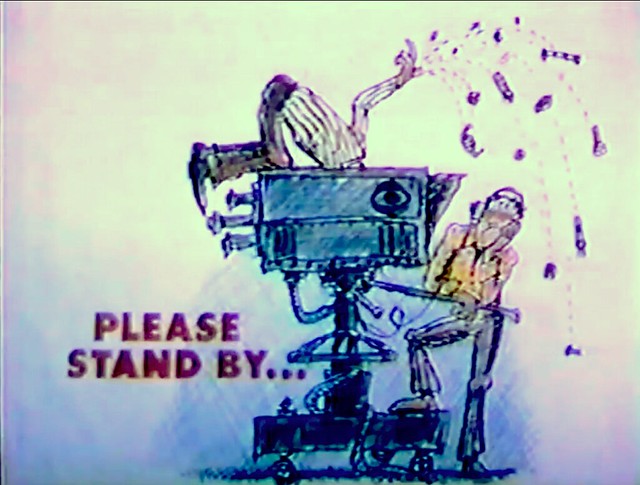 Any time you switch up gear, be that hardware or soft, you risk adding new variables to a project. This post is about how you troubleshoot your workflow. I'll use my most recent shoot to illustrate this:
Any time you switch up gear, be that hardware or soft, you risk adding new variables to a project. This post is about how you troubleshoot your workflow. I'll use my most recent shoot to illustrate this:
For this most recent film I tried a bunch of new stuff shooting on a iPhone at 2K (2048 x 1152, which is just a hair over HD standard of 1920x1080, which allows you to slightly nudge the frame around for the best composition) using Filmic Pro, stabilizing that with the OSMO One, and using footage shot with my thermographic camera. Here are some of the workflow issues that cropped up and what I learned.
1.Camera sound
Hope that gives some of you some ideas of how to troubleshoot your own projects. I'd be interested in any similar experiences anyone has had with workflow changes and challenges.

For this most recent film I tried a bunch of new stuff shooting on a iPhone at 2K (2048 x 1152, which is just a hair over HD standard of 1920x1080, which allows you to slightly nudge the frame around for the best composition) using Filmic Pro, stabilizing that with the OSMO One, and using footage shot with my thermographic camera. Here are some of the workflow issues that cropped up and what I learned.
1.Camera sound
ISSUE:
2. Dropped/Duplicated Frames in FIlmic ProHey, guess what? It's super easy to accidentally zero the audio input on Filmic Pro, so the footage has no sound on it, which means I can't have software automatically sync the second sound (from the audio guy) to picture.
FIX IT IN POST:
- I'll use the slates to manually align sound with picture
- Add "CHECK INPUT LEVEL ON FILMIC PRO" to my pre-shot checklist
- ALWAYS get a VISIBLE CLAP at the start of the take even if we're in a hurry and no time to get the slate proper, as this will always be the sync emergency fallback if all else fails
ISSUE:
3. OSMO One PowerOn a few takes I noticed hiccups where the same frame was duplicated. Mostly invisible at playback speed, but in a few places a take was ruined by visual stutter
FIX IT IN POST:
- I can trim the duplicated frames in most cases, but in a couple of cases this resulted in frames being missed so I either have to cut around this or use different takes
- Basically, I have to do some homework and see if someone else has encountered this and how to avoid it. Otherwise I have to shoot tests and try to figure out what caused the issue
- battery level?
- phone running hot?
- low internal storage space?
- other apps running in the background?
- Will airplane mode with only the bluetooth on help by eliminating potential interrupts?
- gremlins?
- ...and to keep an eye out for it when shooting
ISSUE:
4. OSMO One un-paired with Filmic ProLate in the shoot the OSMO ran out of juice and it took a lot longer than I expected to get it charged to a workable level again.
NEXT TIME:
- Turn the thing off any time it's not needed
- Determine if it can be plugged into charge while ON
- Buy a second battery and (hopefully) a charger
- Plug it in between takes
ISSUE:
5. Filmic Pro mode switched accidentallyOn several occasions I found the Osmo wasn't paired properly with Filmic Pro, so some of the programmed functions weren't working until I re-paired the device from inside Filmic Pro
NEXT TIME:
- Do tests to determine what caused the unpairing
- Was it shutting off the OSMO?
- Something I accidentally triggered in FIlmic Pro?
- Did I accidentally toggle bluetooth on and off?
- Add a "Check pairing with OSMO" entry to my pre-shot checklist to make sure I always do it
ISSUE:
6. Blocking for a handheld shootOn a couple of occasions I found that Filmic Pro wasn't in the same mode I had been using it (suddenly I was on full manual exposure and focus control when I had been shooting in Auto mode with the exposure locked but focus on auto since I was moving so much)
NEXT TIME:
- I suspect I was accidentally thumbing a button on the OSMO that was switching modes on Filmic Pro, so I need to figure out exactly what every paired control does and either change any that cause unwanted results or learn to keep my fingers off the damned control at issue
- Also, Filmic Pro lets you "Save Current Settings as Preset" and I will do this for each project going forward so that I can quickly retrieve the desired settings as needed, and...
- ...I will add a "Re-load presets" entry to my pre-shot checklist to make sure I always do it
ISSUE:
In reviewing the footage I realized I really didn't do a good job with the blocking and camera moves in the first scene we shot. Where I had the actors end up required whip-panning back and forth to cover them, and in retrospect I see that it was the wrong choice because the tone of the scene does not sit comfortably with this kind of camera action and I was missing some of the performance.
FIX IT WITH PICKUPS:
- I could live with it, but I'd rather reshoot it than hurt the scene, so...
- Since the scene really only requires two actors, the sound guy and me, I scheduled a pickup reshoot of the scene for Sunday [EDIT: Which we did]
- Remind myself to think through the tone of the scene and if it's best served by dynamic or more subtle camera moves
Hope that gives some of you some ideas of how to troubleshoot your own projects. I'd be interested in any similar experiences anyone has had with workflow changes and challenges.
Last edited:
That was nice.24fps. Do. It.
One area that wasn't addressed, but which I believe should have been, was the area of motion interpolation.
https://en.wikipedia.org/wiki/Motion_interpolation
For those who don't know, this technology allows content to be delivered at lower frame rates but experienced at higher frame rates, through the synthesis of missing frames by interpolation, with results that are generally convincing though anything but always perfect.
Nevertheless, this technology has an impact on his claims about bandwidth requirements, a main reason being that interpolation is more accurate between frames sampled at a higher frame rate than between frames sampled at a lower frame rate. This is one means of showing the claim that anything that can be done to compress films at 60fps can also be used just as effectively to compress films at 24fps to be at least somewhat overly simplistic, especially when discussing lossy compression.
Another consequence of motion interpolation is that it provides a means of comparing 24fps and 60fps for films shot in 24fps. My personal experience with motion interpolation used in this way is that it proves hands down that 24fps films made by masters should always be viewed in 24fps, because 24fps tended to be factored in as part of the experience. How objective it is, I really don't know, but the "soap opera effect" does seem to be shared experience, one that I definitely experience.
I think his point is that delivery will largely remain at 24fps. In a previous video on frame rates he discusses Trumbull's system which shoots at 120fps and can be throttled down to lower framerates as desired using motion interpolation and other techniques.
The cost still remains an issue in terms of capture, backups and storage unless the system being used writes out to 24fps directly and does this motion interpolation on the fly.
The cost still remains an issue in terms of capture, backups and storage unless the system being used writes out to 24fps directly and does this motion interpolation on the fly.
Precisely.
A good and very practical guide to shooting greenscreen.
Maurice,
Enjoying the tutorial! Particularly the video on green screens--bringing back a lot of memories!
Andy Bray
Chekov from Star Trek: New Voyages
Co-author of "Making Fake Star Trek" a book about fan films
www.MakingFakeStarTrek.com/book
Similar threads
- Replies
- 0
- Views
- 91
- Replies
- 1
- Views
- 476
- Replies
- 4
- Views
- 912
If you are not already a member then please register an account and join in the discussion!

 .
.